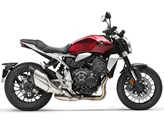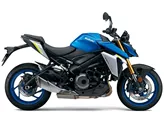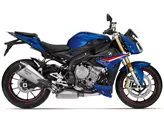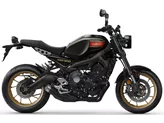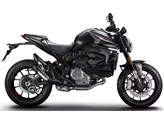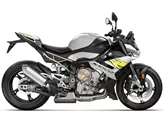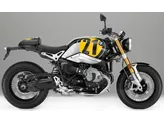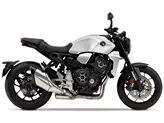Kawasaki Z 800 2013 vs. Honda CB 1000 R 2019

Kawasaki Z 800 2013

Honda CB 1000 R 2019
Overview - Kawasaki Z 800 2013 vs Honda CB 1000 R 2019
The Kawasaki Z 800 model year 2013 and the Honda CB 1000 R model year 2019 are both naked bikes with similar engine types, inline 4-cylinder engines. However, there are several notable differences between the two models.
In terms of engine power, the Honda CB 1000 R 2019 has a clear advantage with 145 HP compared to the Kawasaki Z 800 2013's 113 HP. This means that the Honda CB 1000 R 2019 will have more power and potentially better acceleration.
Similarly, the torque of the Honda CB 1000 R 2019 is higher at 104 Nm compared to the Kawasaki Z 800 2013's 83 Nm. This means that the Honda CB 1000 R 2019 will have better low-end power and more pulling force.
Both bikes have liquid cooling systems, ensuring efficient heat dissipation during operation. This is important for maintaining optimal engine performance and preventing overheating.
In terms of suspension, both bikes feature upside-down telescopic forks at the front. However, the Honda CB 1000 R 2019 offers more adjustability with compression, preload, and rebound adjustments, allowing riders to fine-tune the suspension to their preferences and riding style. The Kawasaki Z 800 2013 only offers rebound adjustment.

Kawasaki Z 800 2013
Both bikes have double disc brakes at the front with four pistons, providing strong and reliable stopping power. However, the Honda CB 1000 R 2019 has the advantage of radial technology, which improves braking performance and feel.
In terms of dimensions and weights, both bikes have 17-inch wheels and similar front tire widths of 120 mm. However, the Honda CB 1000 R 2019 has a wider rear tire at 190 mm compared to the Kawasaki Z 800 2013's 180 mm. This may provide better traction and stability during cornering.
The wheelbase of the Honda CB 1000 R 2019 is slightly longer at 1455 mm compared to the Kawasaki Z 800 2013's 1445 mm. This may contribute to better stability at higher speeds.
The seat height of the Honda CB 1000 R 2019 is slightly lower at 830 mm compared to the Kawasaki Z 800 2013's 834 mm. This may make it slightly more accessible for shorter riders.

Honda CB 1000 R 2019
In terms of fuel tank capacity, the Kawasaki Z 800 2013 has a larger capacity at 17 liters compared to the Honda CB 1000 R 2019's 16.2 liters. This may provide a longer range between refueling stops.
In terms of strengths, the Kawasaki Z 800 2013 has an eye-catching, chunky look and offers confident acceleration. Its relaxed geometry and powerful brakes contribute to a comfortable and enjoyable riding experience.
On the other hand, the Honda CB 1000 R 2019 has a flawless responsiveness of the power unit and is known for being extremely rideable. It also offers a good electronics package, including ABS, traction control, and riding modes. The smooth and precise gearbox and excellent functioning quickshifter further enhance the overall performance and riding experience.
In terms of weaknesses, the Kawasaki Z 800 2013 has limited freedom of movement for the legs, which may be uncomfortable for some riders. The Honda CB 1000 R 2019 has a black/white LCD that may not be up to date and not ideally readable in direct sunlight. Additionally, tall pilots may have space problems with their knees at the tank on the Honda CB 1000 R 2019.
Overall, the Honda CB 1000 R 2019 offers more power, better adjustability, and a more advanced electronics package compared to the Kawasaki Z 800 2013. However, the Kawasaki Z 800 2013 has its own strengths in terms of its unique design and confident acceleration. Ultimately, the choice between the two models will depend on the rider's preferences and priorities.
Technical Specifications Kawasaki Z 800 2013 compared to Honda CB 1000 R 2019
Pros and Cons in comparison
Pros and Cons in comparison
Kawasaki Z 800 2013

Overall, the Z800 delivered a sensational performance. Considering the fact that nothing was changed or optimised on the vehicle apart from the Remus rear silencer, a super final result.
Honda CB 1000 R 2019

The 1-litre version of the Neo Sport Cafe Racer shows that it doesn't always have to be the golden mean. In all honesty, it has to be said that the largest of all the representatives also feels the most "grown-up". The electronic equipment of the 1000 in the + version leaves almost nothing to be desired and the handling is extremely rider-friendly for this class. Playfully easy cornering with a well-tuned chassis, snappy brakes and low weight seem to be the recipe for success in terms of smoothness. In terms of performance, the CB1000R+ unfortunately has to make concessions. With 145 hp, the Honda is not a brute rocket, but it is all the more controllable for it. And 145 hp with a full tank of 213 kg is more than enough for maximum riding pleasure on country roads!
Price Comparison Avarage Market Price Kawasaki Z 800 vs Honda CB 1000 R
There are a few key differences between a Kawasaki Z 800 2013 and a Honda CB 1000 R 2019. In terms of price, the actual average price of a Honda CB 1000 R 2019 is about 56% higher. Compared to Honda CB 1000 R 2019 there are less Kawasaki Z 800 2013 bikes available on the 1000PS.de Marketplace, specifically 7 compared to 16. It takes less time to sell a Kawasaki Z 800 with 56 days compared to 116 days for a Honda CB 1000 R. Since model year 2013 1000PS.de editors have written 11 reviews for the Kawasaki Z 800 and 42 reviews for the Honda CB 1000 R since model year 2008. The first review for the Kawasaki Z 800 was published on 9/6/2012 and now has more than 8,100 views. This compares to more than 10,400 views for the first review on Honda CB 1000 R published on 11/6/2007.





